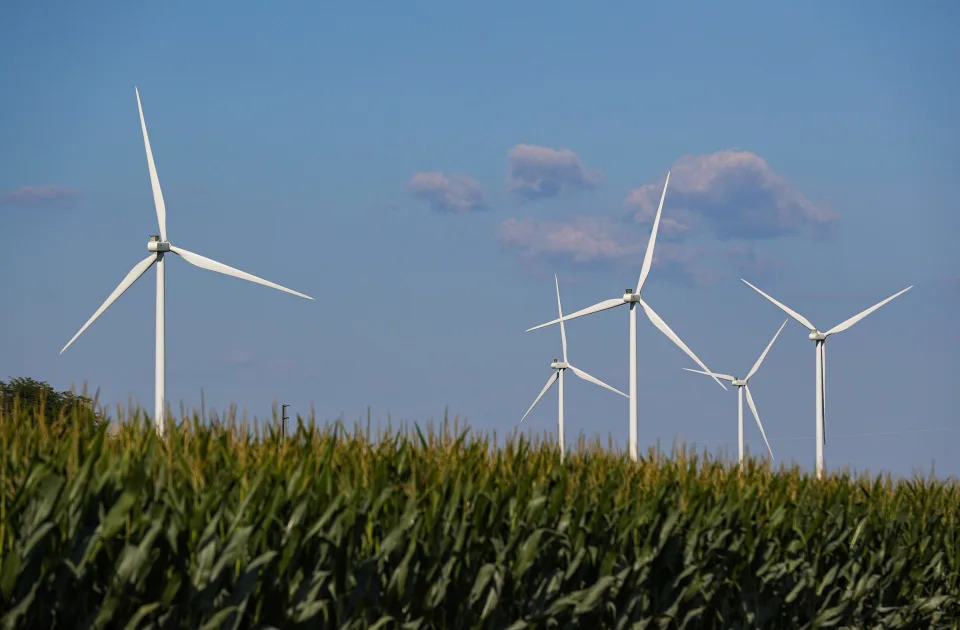IndyStar – The Indianapolis Star
Scrub Hub: Passing a wind farm, I see some turbines spinning and others motionless. Why?
Karl Schneider, Indianapolis Star – January 23, 2023
Wind farms are becoming more common in Indiana. The state already boasts the fourth largest “farm” in the U.S. and produces nearly 3,500 megawatts of wind energy, with more on the horizon.
The towering windmills reaching up to the sky produce slightly more than 9% of all the electricity used in the state. That’s enough to power more than 1 million homes, according to the American Clean Power Association.
With more projects in the works that will produce another 302 megawatts, and a handful of bills proposed in this session of the General Assembly, wind power is likely to continue to grow across the state. And with the increasing presence of the conspicuous energy generators comes some curiosity.
So, for this edition of Scrub Hub, we took to our trusty submission form and chose a question from Teresa, who asked: Why are the wind turbines not turning right now?

It’s possible for the blades on wind turbines to reach up to speeds of 200 mph, so it may seem odd when some are spinning very quickly while the blades on others nearby are not moving.
We dug around in some state, federal and industry reports and reached out to academic experts in energy technology to determine why some turbines in a wind farm spin while others remain still.
Short Answer: The turbine is down for maintenance
Wind turbines, like all machines, need both scheduled and unscheduled maintenance. In some instances that explains why some are operating but not others.
The basic components of a wind turbine are the visible tower and rotor blades, as well as the gearbox and generator located at the top of the tower.
Scheduled maintenance helps prevent wear and tear from breaking parts and unscheduled maintenance occurs when the turbine experiences any of a number of failures.
Regular preventative maintenance can include periodic equipment inspection, oil and filter changes, calibration and adjustment of various parts, as well as replacing brake pads and seals. General housekeeping and blade cleaning can also temporarily keep a turbine from spinning.
In larger wind farms, several turbines on a circuit can be inoperable and not spinning because they are all down for maintenance, said John Roudebush, program chair of Ivy Tech College’s Energy Technology program.
More Scrub Hub:Hoosiers may not be able to plant the same trees they used to
Long answer: Curtailment, congestion and wind speed
Energy transmission in Indiana is run through the Midcontinent Independent System Operator, commonly known as MISO. The group manages the flow of electricity by balancing demand versus what’s being generated, which means there are times where excess electricity is being produced.
“(Sometimes) we don’t need the power as demand is down or another power plant is selling power to the customers instead,” Roudebush wrote in an email. “Power plants compete on the grid. A coal plant, a natural gas plant, or a wind farm will all bid to sell power during some part of the day and MISO will pick the cheapest bid for the day. Generally, wind is the cheapest but not always.”
John Hall, assistant professor at the University of Buffalo’s Engineering and Applied Sciences, focuses his research on the technical aspects of wind energy. While some wind turbines will operate normally, he said others may be stopped to match production with grid demand.
“Basically, you have the utility company distributing power and buying and selling in real time,” Hall said. “Based on how much they need, wind farms would turn turbines off accordingly.”
The industry calls a wind turbine that is not spinning “parked,” Hall said, and this is done with a braking system that holds the rotor in place. Once energy demand rises, the brake is released and almost immediately the turbine starts delivering electricity to the grid again.
Another obvious answer to why the turbines may not be spinning is that the wind speed is not high enough.
Generally, turbines can generate power with wind speeds as low as 5 mph. If speeds fall below that, there just isn’t enough to turn the sometimes massive blades.
On the other hand, wind that is too fast can cause damages to the turbines, so operators of wind farms will park the rotors until the wind calms down. Turbines generally shut down when wind speeds hit about 55 mph.
“The system is not designed for that, so they shut it down,” Hall said. “That’s OK because we rarely get winds over that speed, and it would not be worthwhile to design for that for the few instances.”
To help improve the efficiency of wind farms, Hall said banking excess power is a huge research area right now.
“There are studies on new battery technology and super capacitors and different ways to get around that issue,” Hall said.
More:Toxic pollution, fossil fuels, floodplains: Top environmental bills to watch this session
Another solution for storing excess electricity is by making hydrogen, Hall said. Wind farm operators would be able to create hydrogen and store it for use later when the grid demand increases.
While fossil fuel plants may be more responsive to the constantly moving supply and demand for electricity, Hall said the future depends on renewables.
“If folks are concerned about climate and want a better future for the next generation and everything, renewable energy like wind and hydro-electric and tidal power are all really not just sources of energy but vital to perhaps our existence,” Hall said.
Karl Schneider is an IndyStar environment reporter.
IndyStar’s environmental reporting project is made possible through the generous support of the nonprofit Nina Mason Pulliam Charitable Trust.
